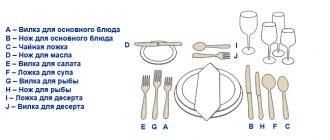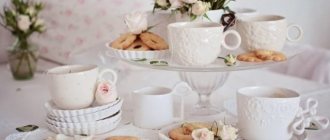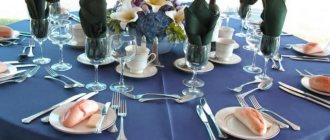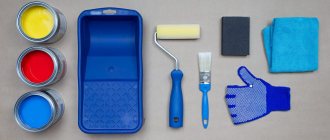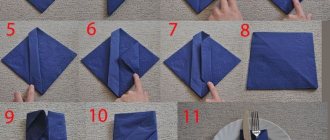Before you start laying out your cutlery and utensils, you need to understand the surroundings. It is also important for a special occasion.
- The generally accepted distance between chairs is from 50 to 80 cm. It is important that all seats are approximately equal in area for harmony.
- Make sure the table is full of dishes. It should only contain food that corresponds to the moment of celebration. For example, only hot dishes or only dessert. Overload creates chaos, which looks ugly and not solemn.
- Decorations, table settings, and food service vary depending on the event. Think through everything to the smallest detail. The timing, quantity and quality of food, as well as many other factors, influence the decor and setting appropriate for the occasion.
- Before the event, you need to resolve all organizational issues, make sure that the tablecloth is in good condition, get and count all the cutlery and dishes, find the required number of chairs according to the number of guests. On the day of the celebration, wipe all the dishes so that there are no stains or dust on them.
Why is table setting necessary?
For some reason, it is generally accepted that it is necessary to set the table correctly only in a restaurant. Nothing like this! Serving is a sign of respect for guests, a sign of the good taste of the owners of the house. It will be useful for everyone to know how to properly place cutlery on the table. You need to be able to create a festive atmosphere at breakfast, lunch, and dinner.
Many table settings, shown in films and TV series or described in books, are frightening because of their complexity.
By the way! Scientists have proven that the production of the joy hormone during eating improves metabolic processes in the body and promotes the absorption of nutrients.
Types of cutlery
Over the course of human history, many food devices have been created. In the process of evolution they underwent changes. Now in the arsenal of many housewives there are sets of cutlery for festive serving made of stainless steel, cupronickel, and silver.
The basic rule of table etiquette is “from the edges to the center.”
Spoons
The dining room is the largest in size. Dessert is ¼ less. The tea room is almost half the size of the dining room, but larger than the coffee room. Sour cream is easy to recognize by its round, pot-bellied shape. For sugar, it is made in the form of a scoop or with a curly ornate handle so that it can be immediately recognized among other spoons.
There may be a lot of cutlery on a set table, but not all of them are there at once.
Important! There are spoons for fruit compotes; they have an elongated handle, instead of the usual spatula there is a scoop for scooping out fruit. Externally, the fruit spoon resembles a miniature ladle. Another wonder is a spoon with an elongated handle for preparing mixed drinks.
Forks
Standard forks with long tines are used for appetizers and main meat courses. A fish fork has shorter teeth to make it easier to remove the bones. Sometimes a fish fork makes a depression in the center. Dessert ones differ in size, the cocotte one has only three teeth, the lemon one has only two.
Today, there are a lot of different cutlery designed strictly for a specific type of dish.
Which side of the plate should the fork be placed on?
- Basic Etiquette
- Rules
- Pre-meal layout
- Arrangement of devices at the end
- Tips for all occasions
- How to effectively set the table: examples
Setting the table is an interesting task, but a lot of cutlery can baffle even an experienced housewife. Forks raise the most questions. As a rule, 4 pieces are used for standard serving. Each one needs to be positioned correctly depending on the menu.
It is better to find out in advance how to place them so as not to get into an awkward position in front of eminent guests.
Basic Etiquette
Knowledge of the basics of etiquette is the foundation of good serving and correct behavior. Such rules dictate to us which side the devices should be placed on and how to use them. Let's consider the rules of application:
- If there are pancakes with filling on the table, they are eaten with a knife and fork.
- There are special forks for fish - 4 tines with a cut in the middle.
- If the fish is served not in portions, but whole, then slightly different utensils are provided. In this case, the fork is round and flat. It is used to place a piece on a plate.
- If you decide to drink water while eating, then place the fork and knife on the edge of the plate, with the handles facing the table.
- You need to place the fork on the left and the knife on the right. The utensil for guests is placed under the hand with which you need to hold the fork.
- Tea is often served with a special small fork with two teeth. It is intended for lemon.
- Some dishes do not require the use of a knife. In this case, it is acceptable to hold the fork in your right hand.
There are separate forks for fruit. So, it is customary to eat bananas with their help. Dessert forks are often used for cakes with a lot of airy cream. In this case, a fork is considered an acceptable alternative to a spoon.
For a simple family meal, it is enough to put one table fork on the table, this is quite enough. With holidays and celebrations everything is different. So, the following forks must be present on your holiday table:
- Big. Visually it resembles a simple dinner fork, but is larger in size. It is used to move food from tray to plate.
- The dining room is large. Used for meat dishes.
- Small. It is used to eat snacks and desserts.
- Fish and seafood. The name of the forks speaks for itself. The devices are small in size.
- For fruit. This device is served at the end of the meal.
Rules for serving cutlery
Immutable rules of serving: cleanliness and neatness. Each cutlery made of non-ferrous metals is polished to a shine on the eve of the celebration. The tablecloth is bleached, starched for rigidity, and ironed.
A classic and win-win option is a snow-white tablecloth. She always looks elegant and solemn.
The dishes are arranged so that there is enough space for cutlery. How many dishes there are so many spoons and forks.
The minimum distance between them is 1 cm.
Choosing a tablecloth for the table
At special events, a light tablecloth made of natural fabrics: linen or cotton is recommended. The tablecloth should cover the entire tabletop and hang down to the sides by 20–30 cm.
The tablecloth should be combined with curtains and upholstery.
Important! Stains from starched fabric are easier to remove; they are not absorbed into the fibers and remain in grains of starch, which are easily washed out of the fabric.
Serving plate
The lower large plate is placed 5–7 from the edge, dishes for main courses are placed on top, and a snack bar is placed even higher. A deep bowl for soup is placed on it. Broths are served in special deep cups. The pie plate is placed on the left, away from the edge, the tea cup and saucer is placed on the right, at a distance of 3 cm from the dessert knife. Plates on the table play a key role; they are the basis of serving.
It is the responsibility of the housewife to promptly replace the plates with clean ones.
Arrangement of spoon, fork and knife
Knives are placed to the right of the plates, blade to the edge, forks to the left. The number of forks must correspond to the number of knives. Place the soup spoon next to the outermost knife. Cutlery for those dishes that are served earlier is placed closer to the edge of the plate, the rest are nearby, taking into account the order in which the food is served. With an extensive menu, which includes meat and fish appetizers or a main dish, first put a knife for meat, then for fish. The location of the teaspoon and coffee spoon is the same, on a saucer; a knife for butter or cutting pies is on a pie plate.
Beautiful layout examples
One way or another, there is currently an opinion that only restaurant establishments observe all the subtleties of serving. In fact, this knowledge can be applied to all kinds of family celebrations and other important holidays. There are several common examples:
- Serving a romantic dinner for two requires an intimate atmosphere, dim lighting and, of course, the presence of suitable glasses. Additional accessories in the decoration will add a special touch of intimacy. You can start by choosing a color scheme, based on the preferences of your other half, and then you can add significant details: put your favorite flowers, ribbons, memorable souvenirs, a general photo. Music and lit candles of various shapes and sizes will be an integral accompaniment.
- An important celebration in a close family circle requires respect for tradition and a classic serving style. The difference between generations is of particular importance, therefore both the style of serving and the overall design of the table should be as generally accepted as possible, not too bright, but solemn in its classics. Restraint combined with solemnity can be expressed in beautifully selected expensive dishes (crystal items are appropriate), cutlery, snow-white napkins and the presence of accents, for example, gold and silver.
- Often a ceremonial meal is associated with the celebration of some event . This is where themed table settings come to the rescue. The New Year's or Christmas table is complemented with coniferous products and Christmas tree accessories; sometimes the table setting is decorated with a combination of burgundy, red and green colors.
- For the autumn holidays, tables are set with the addition of gems, small seasonal vegetables, acting as accessories. The compositions are complemented with suitable colors.
- Summer wedding celebrations will be complemented by light fabrics, delicate pastel colors and thin glassware.
It is very important not to limit your imagination and embody any creative ideas, applying knowledge in table decoration. Any celebration begins with competent table setting, which is sure to make a pleasant impression on all participants in the celebration.
You will learn more about which side of the plate to place the fork and knife according to the rules of etiquette in the following video.
Types of table settings
Each type of meal requires a special atmosphere. An ordinary lunch, of course, differs from a festive dinner. When only dessert is served, the table should not appear empty.
Descriptions of several classic options for a set table will help awaken your imagination.
Table setting for breakfast
An individual decorative napkin is placed for each family member. Place a snack plate in the center and put cutlery. On the left is a place for a pie plate. Nearby is a glass for juice or water. A coffee or tea pair with a spoon is located on the right.
Vases with flowers, napkins and cutlery with spices are usually placed in the center of the table.
For a shared breakfast, it is acceptable to serve sliced bread in a nice small bread bowl and butter in a butter dish. Sliced meats are laid out in an elongated dish, the cheese is usually not cut, served in one piece on a flat plate or serving board, each cut as much as needed for breakfast. Paper napkins are placed in a napkin holder next to the spice set.
Bread can be served in a wicker basket, and butter can be served in a butter dish made of ceramic or porcelain.
Dinner and supper
Lunch involves frequent changes of dishes; the dishes are arranged so that everyone sitting at the table can be approached from the left side. After arranging the cutlery, choose a place for the tureen; place a ladle next to it on a ceramic stand so that there are no stains on the tablecloth. Shared hot dishes are laid out so that everyone can reach the plate independently; usually 4 servings are placed on a common plate. Slices and appetizers are designed for 6 people or arranged individually for each person.
The dinner table is set in such a way that guests can be served conveniently and quickly.
Proper table setting for dessert
The service will make the dessert table elegant and sophisticated. It’s beautiful when there is a teapot, candy bowls, a sugar bowl, and croutons with cookies in the same style on the table.
A dessert plate is placed in front of each person, next to a couple for a hot drink. Appropriate:
- wine glasses;
- juice glasses;
- glasses for water.
The ideal option would be to use a special service.
Bowls for jam and preserves are placed next to the dessert plate on the right, away from the edge of the table. It is better to buy lace napkins. The tea bags are placed in baskets or on saucers, the coffee is placed in jars, and a long-handled spoon is placed on top. Boiling water is best served in a large porcelain teapot. Lemon slices are laid out on a special tray.
MAGAZINE about modern tableware and gastronomy
Table etiquette is not a relic of the past. Good manners are always in fashion. This is a proven way to win people over and win sympathy. Here are a few simple, clear rules of behavior at the table that will help you not lose face, be it a social event or a regular dinner in a restaurant.
The basics of feast culture
- Knowing how to use cutlery is not a very complicated science. Each device has a purpose. In order not to get confused which one is needed and why, keep a hint in mind. As new dishes are served, we move from the outermost cutlery to the one that lies near the plate.
Let's take a closer look at what cutlery you will need for different dishes:
- Cold and hot snacks - snack fork and knife
- Snacks in a cocotte maker - snack fork or spoon
- Hot fish - fish fork and fish knife
- Hot meat dishes - table fork and table knife
- Omelettes, casseroles, vegetables - dinner fork
- Desserts - dessert spoon or dessert fork
- There is an exception for minced meat dishes. If you are served cutlets, cabbage rolls or meatballs, you can get by with one dinner fork.
- Meat steak or chop should be cut into small pieces with a knife and fork. Only after you have chewed can you cut off the next piece. Cutting everything at once is considered bad manners. In addition, then the meat will cool faster and will not be as tasty.
- According to classical European etiquette, the knife and fork are held in your hands the entire time you eat the dish. More informal American etiquette allows you to place the knife on the edge of the plate if it is not needed at the moment. The fork is transferred to the freed right hand.
- It is customary to eat first courses with a tablespoon, trying not to make any sounds. If the soup contains meatballs or dumplings, you won't need a knife and fork anyway. You only need to use a spoon. Nobody forbids you to finish the soup. To do this, tilt the plate away from you and carefully pour the remainder into a spoon. After this, it should be placed on a plate.
- If you want to make a sandwich, place a slice of bread on a pie plate. Lightly holding the bread, spread it with a thin layer of butter. Holding bread in your palm is unhygienic. A piece of cheese or ham must first be pricked with a fork and only then placed on the bread.
- You can eat bread, cakes, cookies, almost all fruits and berries with your hands. At the same time, it is not customary to bite off bread. Pinch off a small piece from the slice and put it in your mouth. Fruit and berry seeds are first placed on a spoon or fork and only then on a plate.
In the language of cutlery
If dinner is taking place in a restaurant, it would not be a bad idea to master some conventional signs expressing this or that wish. A professional waiter will easily decipher them and fulfill your request.
- The fork and knife lie on opposite sides of the plate, crossing a little higher. This comes in handy if you need to step away for a minute or are deep in conversation but don’t want your dish to be taken away.
- The fork and knife lie in the center of the plate perpendicular to each other (fork vertical, teeth up) - “I’m waiting for the next dish.” You will need it if you are in a hurry and want to subtly hint about it.
- The fork and knife lie horizontally and parallel to each other in the center of the plate, both ends on the right side - “I finished eating, I liked the dish.” A small compliment to the address.
- The knife and fork are crossed in such a way that the blade passes through the teeth at an angle - “I finished eating, I didn’t like the dish.” It's perfectly acceptable if you want to make a silent protest.
- The fork and knife lie parallel to each other in the center of the plate at 5, 6 or 7 o'clock, both ends pointing upward - "I've finished eating, bring the bill."
- Under no circumstances should you place cutlery on a tablecloth or cloth napkin. This is a blatant violation of table etiquette.
Table taboos
Etiquette doesn’t end with knowing how to use cutlery. There is an unspoken code of conduct at the table that you should also know. Here are a few more typical violations that are extremely undesirable at the table.
- You should not publicly say that you are on a diet. Express gratitude and politely refuse forbidden foods without going into details. This also applies to alcohol. If you don’t want to drink for some reason, you shouldn’t focus everyone’s attention on it. Ask for juice or mineral water to be poured into your glass.
- Placing a smartphone on the table is bad manners. This is only acceptable if you are expecting an important call. Warn about this in advance and, when they call you, leave without attracting unnecessary attention. In other cases, it is better to switch your mobile phone to silent mode.
- If you accidentally drop cutlery (whether at a party or in a restaurant), you should not reach under the table for it. Tell them to bring you clean utensils. If you are asked to pass a fork or spoon at the table, take it in the middle with your fingers, handle forward. The knife is passed with the handle away from you.
- It is not customary to place a handbag on a chair or lap. You can hang it on the back of a chair or place it on the floor next to you. But it’s quite acceptable to put a miniature clutch on the table if it doesn’t bother anyone.
- A toothpick is a personal hygiene item. Therefore, it should not be used in public under any circumstances. Wait for the right moment and go to the restroom to calmly remove the piece of food remaining in your teeth. If you're hosting a dinner party at home, place toothpicks in a visible place in the bathroom.
As you can see, there is nothing burdensome or unenforceable in table etiquette. Following this unspoken protocol is a simple and reliable way to show your gratitude to those who hosted your evening of luxury. A warm, friendly atmosphere will make it even more enjoyable.
The Importance of Choosing the Right Table Color Scheme
When setting a table, the tablecloth is chosen according to the type of event. For everyday use, variegated or plain fabric with acrylic coating is allowed, the main thing is that it matches the colors of the dishes.
Shades of red stimulate the appetite, while cool blue tones pacify it. Yellow and orange create a good mood, green have a calming effect.
The principle of arrangement of cutlery: the dish that is served first is the farthest cutlery.
It is better to decorate a romantic dinner in dark colors so that burning candles look advantageous. There is no need for unnecessary details on the table that interfere with communication: vases with flowers, multi-tiered fruit stands.
A formal event requires moderate, muted tones and crystal tableware. Themed parties will be memorable if the tablecloth contrasts with the colors of the dishes.
Setting a holiday table is also an opportunity to show your creativity.
How to put it after eating?
To indicate that you are ready to serve the next dish, simply cross the cutlery directly on the plate, turning the knife to the left and the fork to the right. If the meal is already finished, you need to place the cutlery parallel to each other diagonally across the plate.
In the European style, you can observe that in this case the tines of the fork will be turned towards the plate, and in the American style the fork will be placed with the tines up.
Additional decorations for serving
The decor should not be conspicuous; it complements the serving of dishes. Inappropriate:
- high compositions;
- vases with huge bouquets blocking the view;
- strong-smelling bouquets; guests may be allergic to them.
Decorate with napkin holders and candlesticks. Originally folded fabric napkins are an ideal option for decorating a formal table. Flowers from vegetables and fruits, edible compositions are appropriate for any dinner, they have a place on the dessert table.
A win-win option is to use flowers. Usually they are placed in the middle of the table - it can be a bouquet or composition.
Knowing the secrets of serving, you can turn a traditional meal into a wonderful meal, where everyone will enjoy not only the food, but also the contemplation of the feast. It's so easy to give joy to your loved ones! Make every family lunch and dinner special.
In what order are the dishes served?
Consistent consumption of food affects appetite, enjoyment of food and communication with people. You should not get too carried away with a certain category of dishes; you need to leave room for the rest of the food. You can determine the approximate amount of food by the number of cutlery.
Standard sequence of serving dishes:
- Cold appetizers.
- Hot appetizers.
- First course.
- The second hot dish is fish.
- The second hot dish is meat.
- Dessert – sweet snacks.
- Fruits.
Snacks are also arranged in a certain order: fish, meat, vegetables and mushrooms, dairy.
The menu may be different, but the sequence should remain the same. It is allowed to remove unwanted items. In this case, the rest of the food is served in the same predetermined stages (i.e., if the hot appetizer is removed, it will still be followed by the first course).
About the sequence of serving dishes in the video:
